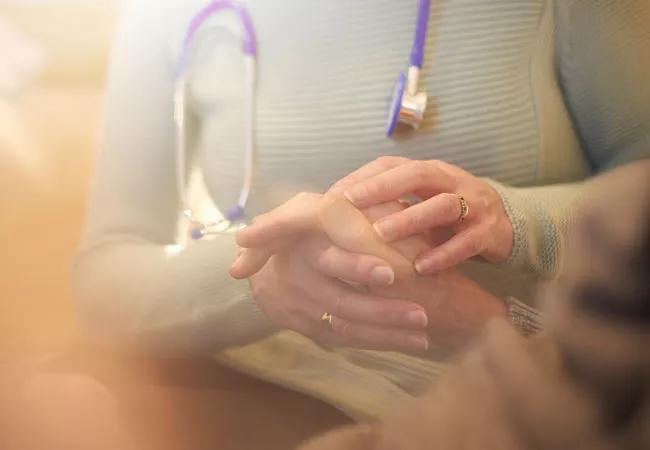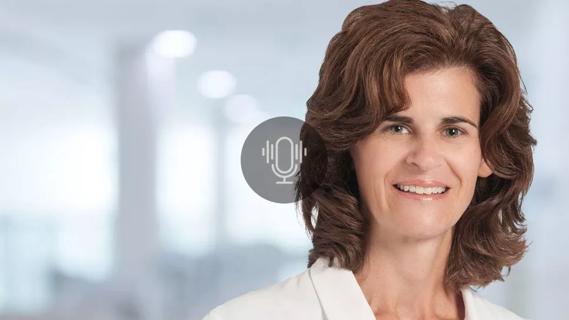Advertisement
What it takes to care for end-of-life patients

Hospice and palliative care nurses acknowledge that although the work can be emotionally draining, it’s also incredibly rewarding. “I am so glad I moved into hospice nursing because I feel like I make such an impact on patients and their families,” says Holly Thompson, RN, who has been a nurse with Cleveland Clinic Hospice for two years. “We help patients pass over peacefully and help their families understand that for most patients, this is a welcome experience. They no longer have to suffer and deal with the pain and side effects of treatments.”
Advertisement
Cleveland Clinic is a non-profit academic medical center. Advertising on our site helps support our mission. We do not endorse non-Cleveland Clinic products or services. Policy
Thompson is one of approximately 40 hospice and palliative care nurses at Cleveland Clinic who work in patients’ homes, long-term care facilities, assisted living and group homes. In 2014, the healthcare system began an inpatient hospice program to provide dying patients in the hospital with appropriate end-of-life care services.
Most people enter the nursing profession to help heal patients, but few consider assisting patients with terminal illnesses so they can pass away peacefully and comfortably. However, death is a natural part of life, and nurses are critical to the pain and symptom management, family support and 24-hour care offered by hospice programs. In 2014, an estimated 1.65 million patients received services from hospice, according to the National Hospice and Palliative Care Organization.
“Rather than viewing end-of-life as sad, it’s uplifting and inspirational to help patients at this stage of their life journey,” says Trisha Peace, BSN, RN, CHPN, Cleveland Clinic’s Hospice Clinical Manager. “Patients have chosen to die their way, with dignity and respect. Hospice nurses are patient advocators and a necessary part of this process.”
Nurses in the practice area focus on the physical, psychological, emotional and spiritual needs of patients and their families. This is accomplished in collaboration with an interdisciplinary team that typically includes physicians, social workers, chaplains and case managers.
The multidisciplinary approach to care is one of the things that Thompson enjoys most about her job. “We may not see each other as often as you would in a hospital, but we have a closer bond,” says Thompson. “We are always available for each other. Our best resources are the rest of the team.” Every two weeks, she meets with her interdisciplinary team to discuss the status of patients. When there’s a new admission, the physician educates the team on what signs and symptoms to be aware of and how the disease may progress.
The day-to-day work of a hospice nurse is quite varied. “We kind of have to be a jack-of-all-trades,” says Thompson. “We are counselors and mediators between patients and families. We are educators, going over care instructions and new medications that patients may be unfamiliar with or scared to use.” In addition, hospice nurses perform routine nursing tasks, such as checking vital signs, assessing patients and entering information in the electronic medical record.
Advertisement
“Our main job is to make sure our patients and families feel well supported,” says Thompson. She typically starts her day by reviewing patients’ records for 20 minutes or so, then she’s “off and running to visit patients.” Thompson usually sees between four and six patients daily. She visits all her patients at least once a week, though it may be more often depending on where they are in the process and how much symptom management or extra support they need.
Hospice nurses at Cleveland Clinic are required to have at least two years of clinical experience. They receive approximately 10 to 12 weeks of training, including a mix of classroom and hands-on learning with a preceptor. It’s a unique specialty since nurses may deal with an elderly patient with chronic obstructive pulmonary disorder during one visit, then head to the home of a child with glioblastoma.
Thompson is touched by all her patients. She recently cared for a patient with a wife and three young children. “They depended on me for knowledge and help with the transition in allowing their husband and father to pass peacefully,” she says. Thompson is currently caring for a woman with cancer who is planning one last trip with her family to the Outer Banks. Thompson is helping coordinate that trip with a hospice program in North Carolina so the patient will have access to care in the event of an emergency. The care team also is making medication adjustments to ensure that the patient will have enough energy to walk on the beach with family.
“Palliative medicine and hospice aren’t talked about as much as chemotherapy, radiation and other active treatment in hospitals,” says Thompson. “But we do so much good for patients and families during this difficult time. We make a huge impact.”
Advertisement
Advertisement

Education, training and reporting can help reduce workplace violence in healthcare

Wound, ostomy and continence nurses provide skin assessments, wound prevention measures, treatment and education

Virtual model enables around-the-clock management of common acute conditions

Resources, education, mentoring help nurses segue to formal leadership roles

Holistic nurses work across all nursing specialties to support patients and caregivers

Nurses play pivotal role in patients’ ability to recover in the comfort of their own homes

Advocating for patient safety is imperative in fast-paced surgical settings

Advice for those pursuing a WOC nursing career